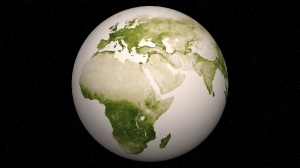A Green Earth: Life seeks to survive, by whatever means it can (picture credit: NASA Goddard Space Flight Centre)
Does evolution have a purpose? To some people, the very notion of ‘purpose’ within natural science is anathema, in that it implies a conscious will directing the universe. But within well-defined boundaries, purpose is a very useful concept in biology. Within the context of the human body, for example, it is useful to consider the heart’s ‘purpose’ as being to pump blood to keep the body alive, even though the organ originated in a long series of random evolutionary mutations across geological time that were directed by natural selection and not necessarily by any conscious ‘will’.
Similarly, we can set evolution within the context of the Earth as a whole. Earth isn’t just an ordinary planet: Earth is, in a sense, alive, and evolution’s purpose could be construed as the mechanism by which this life is preserved. Over time, evolution pushes life towards increasing diversity. We have discovered species living in every conceivable environment on Earth: so-called ‘extremophiles’ manage to survive even in the coldest arctic ice, the darkest caves and the deepest chasms of the oceans. Evolution favours this diversity because diversity begets resistance to disaster. The more environmental niches life can exploit, the less likely it is to be completely wiped out in the event of an asteroid impact or sudden global climatic change. Indeed, life tends to surge back from extinctions such as that of the dinosaurs: they were replaced by an explosion of mammals as the dominant animal species group.
On a macro-evolutionary scale, then, life knows no boundaries. Evolution pushes it to invent every conceivable way of living – from single-celled bacteria to hugely diverse animals with complex organs such as brains. The reoccurrence of the same necessities at many different times and places sparks the re-invention of systems as complicated and functional as photosynthetic cells and eyes. Through ‘adaptive radiation’ life-forms spread everywhere that they can find space to survive – into every niche not already occupied by a better-adapted species. Life can even survive on the craft we launch through the inhospitable expanses of space, a concern for those wishing to seek out virgin vivacious alien worlds. One could argue that human civilisation, which in the short term is causing biodiversity loss on a scale unseen for millions of years, may be evolution’s way of ensuring life’s long-term survival through the development of minds intelligent enough to export life to other planets.
But to defend sterile man-made environments as a part of natural evolution may be going too far. After all, mass-extinctions such as the one that the Anthropocene has ushered in are exactly the enemy that evolution moves to vanquish. Although life will rebound eventually, on the micro-evolutionary scale – that is, the scale relevant to individuals within individual species – the picture is much grimmer. For all but the lucky, persistent few, mass-extinctions represent an evolutionary dead end. The entire species dies out, and all its members suffer. We needn’t worry about the planet as a whole: Mother Nature will continue to tend her garden in the long term. But for each of us as individuals, and the other creatures with whom we value shared existence on this planet, the fact that future species’ adaptive radiation will eventually refill the niches we’ve left vacant is little consolation. Mass extinction will be terrible for the vast majority of beings that have co-evolved to live together. We must make it our purpose to ensure, for our own as well as Nature’s sake, that it doesn’t happen.
![The Purpose of Life A Green Earth: Life seeks to survive, by whatever means it can (picture credit: NASA Goddard Space Flight Centre) Does evolution have a purpose? To […]](/wp-content/uploads/2014/11/Herbal-Earth-640x361.png)
